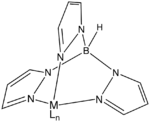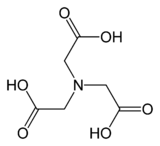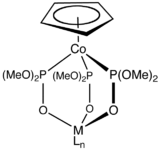Tripodal ligand

Tripodal ligands are tri- and tetradentate ligands with C3 symmetry. They are popular in research in the areas of coordination chemistry and homogeneous catalysis. Because the ligands are polydentate, they do not readily dissociate from the metal centre.
Coordination chemistry
When used in coordination complexes with an octahedral molecular geometry the tridentate tripod ligands occupy one face, leading to a fixed facial (or fac) geometry. The tetradentate tripodal ligands occupy four contiguous sites, leaving two cis positions available on the octahedral metal center. When bound to four- and five-coordinate metal centres, these ligands impose C3 symmetry, which can lead to uncommon ligand field splitting patterns. Tripodal ligands are often able to coordinately saturate metal ions with lower coordination numbers.
One tripodal ligand of commercial significance is nitrilotriacetate, N(CH2CO2−)3 because it is cheaply produced and has a high affinity for divalent metal ions. Other tripodal ligands include tren (N(CH2CH2NH2)3) and certain triphosphines such as RC(CH2PPh2)3. Many kinds of donor groups have been incorporated into the arms of these ligands, including amido (R2N−),[1] and N-heterocyclic carbenes.
- Tripodal Ligands Examples
-

A tripodal triphosphine, X can be CR, SiR, Si−, BR−, B, N, P etc.[1]
-
amine_(structural_diagram).png)
Tris(2-pyridylmethyl)amine, a tetradentate tripodal ligand popular in bioinorganic chemistry.[2]
-

Structure of a metal complex of trispyrazolylborate, an anionic tridentate tripod ligand because it simulates three imidazole ligands.[3]
-

NTA is a commercially important tripodal ligand. Its three carboxylic acid groups undergo deprotonation upon complexation.
-

The Kläui ligand, a dianionic organometallic ligand.
- ^ Saouma, C. T., Peters, J. C., "M-E and M=E complexes of iron and cobalt that emphasize three-fold symmetry (E = O, N, NR)", Coord. Chem. Rev. 2011, 255, 920. doi:10.1016/j.ccr.2011.01.009
- ^ Blackman, A. G., "Tripodal tetraamine ligands containing three pyridine units: the other polypyridyl ligands", Eur. J. Inorg. Chem. 2008, p 2633. doi:10.1002/ejic.200800115
- ^ Parkin, G. "The bioinorganic chemistry of zinc: synthetic analogues of zinc enzymes that feature tripodal ligands" Chemical Communications 2000, 1971-1985. doi:10.1039/B004816J
References
- ↑ Verkade, J. G., "Atranes: new examples with unexpected properties", Acc. Chem. Res. 1993, volume 26, 483.doi:10.1021/ar00033a005